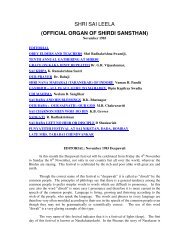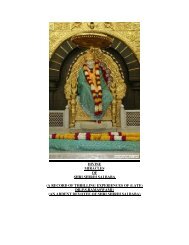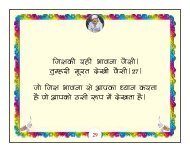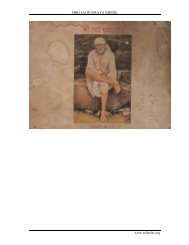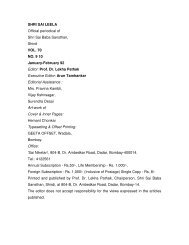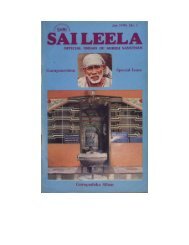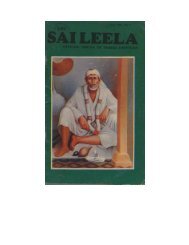Shri Akkalkot Swami Maharaj and Shri Sai Baba (Source Shri Sai ...
Shri Akkalkot Swami Maharaj and Shri Sai Baba (Source Shri Sai ...
Shri Akkalkot Swami Maharaj and Shri Sai Baba (Source Shri Sai ...
- No tags were found...
You also want an ePaper? Increase the reach of your titles
YUMPU automatically turns print PDFs into web optimized ePapers that Google loves.
Accordingly Bhai went to Shirdi where he resided for six months. To commemoratehis vision, he installed padukas of <strong>Akkalkot</strong> <strong>Swami</strong> on the full moon day in themonth of Shravan ( August ) 1912 und the foot of the neem tree. The padukas wereduly installed Dada Kelkar <strong>and</strong> Upasani <strong>Maharaj</strong> officiated at the ceremony. Thedaily worship of the padukas was entrusted to a Brahmin the name of Dixit <strong>and</strong> thegeneral supervision was carried out Sagun [12].<strong>Shri</strong> B. V. Deo gives a somewhat different version according to which thepadukas are not of <strong>Akkalkot</strong> <strong>Swami</strong> but of <strong>Sai</strong> <strong>Baba</strong>. The story goes that sometime in1912, Doctor Ramrao Kothare of Bombay visited Shirdi for <strong>Sai</strong> <strong>Baba</strong>'s darshan.He was accompanied by his compounder <strong>and</strong> friend, Bhai Krishnaji Alibagkar. Aftertaking counsel with Sagun Meru Naik <strong>and</strong> G. K. Dixit two devotees of <strong>Baba</strong>, Bhaithought of commemorating the event of <strong>Sai</strong> <strong>Baba</strong>'s first coming to Shirdi <strong>and</strong> it wasdecided that the best way of doing this was to install his padukas under the Neem tree.When informed, Dr. Kothare liked the idea. He drew up a plan of the padukas <strong>and</strong>showed it to Upasani <strong>Maharaj</strong> who was then staying at Kh<strong>and</strong>oba temple inShirdi. Upasani <strong>Maharaj</strong> incorporated therein motifs of lotus, conch, disc etc. <strong>and</strong>composed a Sanskrit verse in praise of <strong>Sai</strong> <strong>Baba</strong> <strong>and</strong> the holy Neem tree which is asfollows :A free rendering of this is : I bow- to Sadguru <strong>Sai</strong> Nath (vho by his constantabode at the foot of the Neem tree made the ree, which is bitter <strong>and</strong> unpleasant, into anectar-giving one <strong>and</strong> •etter than the Kalpa-Vriksha ( the boon-giving tree )".On the advice of <strong>Baba</strong>, the padukas were installed under the Neem tree on thefull moon day in the month of Shravan in 1912. On that day, at 11 00 a. m., <strong>Shri</strong>
G. K. Dixit carried the padukas on his head from Kh<strong>and</strong>oba temple to Dwarkamai where<strong>Baba</strong> blessed them before their installation. A day before, <strong>Baba</strong> also gave for thispurpose a sum of Rs. 25/~ which he had received a day earlier from a Parsi devoteenamed Pastashet. Bhai was present at the installation of the padukas <strong>and</strong> he wanted togo to <strong>Akkalkot</strong>, thereafter, but <strong>Baba</strong> dissuaded him saying that he <strong>and</strong> <strong>Akkalkot</strong> <strong>Swami</strong><strong>Maharaj</strong> were one. So Bhai then dropped the ea of going to <strong>Akkalkot</strong> on that occasion[13].Sagun Meru Naik in his statement also confirms that the marble stone padukasinstalled in 1912 were of <strong>Sai</strong> <strong>Baba</strong> but his account varies from <strong>Shri</strong> Deo's as regardssome details. Accordingly to Sagun Meru Naik, Bhai Alibagkar was a vendorof agarbattis Though Bhai conceived the idea of installation of <strong>Baba</strong>'s padukas,he being poor, the whole of the expenses were practically borne by Dr. RamraoKothare. <strong>Baba</strong> gave Rs. 25 -as his contribution Four Brahmins, representing the fourVedas,! were brought from Kopargaon for performing the ceremony <strong>and</strong> they wereassisted by Balasaheb Bhate, Bapusaheb Jog, Dada Kelkarj <strong>and</strong> Upasani <strong>Maharaj</strong> [14].The padukas that one sees today are not those installed in 1912. Foi, sometimelater, one Mart<strong>and</strong>, a mad Brahmin living on bounties from <strong>Baba</strong> broke the padukaswith a huge stone. He' also destroyed the idols in Mahadeo-Parvati temple. <strong>Baba</strong>was' sked whether new padukas should be installed in place of the broken once.<strong>Baba</strong> did not approve of the idea <strong>and</strong> advised that anna-shanti would suffice. Soabout two to three hundred people were fed as a part of the Shanti ceremony [15] /It makes no difference whether the padukas are of <strong>Akkalkot</strong> <strong>Swami</strong> or of <strong>Sai</strong><strong>Baba</strong>. As <strong>Sai</strong> <strong>Baba</strong> avers, the two are one <strong>and</strong> indivisible. The worship of one is theworship also of the other. Their oneness <strong>and</strong> unity of spirit has been proclaimed byboth these sages <strong>and</strong> it will be well to bow to them both it reference. Some tales aiealso told which show the nexus orthe close connection between these spiritual giants <strong>and</strong>are worth noting.'STORY OF- G. N. AMBDEKARGopal Narayan Ambdekar of I'une was a devotee of <strong>Sai</strong> <strong>Baba</strong>. He was inGovernment service in the Excise Departme from which he had to retire after ten years'service. He tried get other suitable employment but without success. Gradual his
fortunes declined <strong>and</strong> he fell on evil days. Seven years elapsed. He Visited Shirdi everyyear <strong>and</strong> importuned <strong>Baba</strong> to improve his condition. Finally, he become desperate <strong>and</strong>being unable to bear his suffering any longer, the thought of committing suicide tookhold of his imagination. He came to Shirdi with his family <strong>and</strong> stayed there for twomonths. One night, while sitting on a bullock cart outside Dixitwada, he was so muchovercome with melancholia that he proposed ending his life by [throwing himself in awell; but <strong>Sai</strong> <strong>Baba</strong>, the omniscient, had a plan to prevent his watery grave. A few pacesaway from where Ambdekar sat was a kiosk of Sagum Meru Naik, a <strong>Sai</strong> devotee.Sagun came out at the appropriate moment with a biography of <strong>Akkalkot</strong> <strong>Maharaj</strong><strong>and</strong> asked Ambdekar whether he had read it, Ambdekar took the book in his h<strong>and</strong> <strong>and</strong>while turning over its pages, his attention was riveted on a tale of VamanbuwaBododekar which mirrored his own condition. [16]Vamanbuwa Badodekar was a staunch devotee of <strong>Akkalkot</strong> <strong>Swami</strong>. He hailedfrom Wambori, a village seven miles off Ahmednagar. He had, in turn,worked as a school-master, a clerk in the Collector's Office at Dhulia <strong>and</strong> later ina printing al press at Ahmednagar. Being inclined towards religious <strong>and</strong> scholarsticpursuits, he found no pleasure in these jobs <strong>and</strong> was restless at heart. Heoften mixed with fakirs, sannyasins <strong>and</strong> <strong>and</strong> religious mendicants. Once at Poona hewas directed by a Brahmin to seek guidance from <strong>Akkalkot</strong> <strong>Maharaj</strong>.Vamanbuwa accordingly went to <strong>Akkalkot</strong> <strong>and</strong> took refuge in <strong>Swami</strong> <strong>Maharaj</strong>. In 1876,Vamanbuwa was suffering from a multitude of ailments <strong>and</strong> was disgusted with life.Cough, rheumatism, eye-trouble, piles, diarrhoea <strong>and</strong> a number of other disordersassailed his body . <strong>and</strong> he could get no sleep. At that time he was staying with his 'family at Baroda. He lost all hopes of survival; but all the same continued with hisdevotional worship of <strong>Akkalkot</strong> <strong>Swami</strong>. He sent letters to <strong>Swami</strong>, telling him of hiscondition <strong>and</strong> praying for relief, but received no reassurance. So in a fit of depressionhe decided to end his life. Stealthily, one night, he approached the lake I Sursagar,entered the waters <strong>and</strong> was about to drown himself when <strong>Akkalkot</strong> <strong>Swami</strong> appearedto him in person, pulled him out of jaws of death by his h<strong>and</strong> <strong>and</strong> slapping him hard,scolded hi thus: "Why do you want to end your precious life? Unless you work out yourkarma, you have no release. Why do yo fret ? Your aim should be Sahaj Samadhi ( i. e.
3. Asking for dakshina was not uncommon for both but <strong>Sai</strong> <strong>Baba</strong> was more oftenasking for dakshina in the spiritual interest of the devotees. j4. Both <strong>Swami</strong> <strong>and</strong> <strong>Baba</strong> are known to have taken on themselves the karmicsuffering of their devotees. Similarly the remedies prescribed by both of them were veryunconventional <strong>and</strong> strange <strong>and</strong> the wonder of it was they worked !5. Though they were adepts in yoga <strong>and</strong> possessed the eight major siddhis, theyperformed miracles only sparingly <strong>and</strong> referred disparagingly to the exhibition of siddhis<strong>and</strong> did not set store by them.6. It is their promise to their earnest devotees that they will ever be with them<strong>and</strong> help <strong>and</strong> succour them.This is not a complete catalogue of their qualities <strong>and</strong> powers. Only as amatter of observation, some similarities notice-'able between these two saints have beenstated. Their existence "did not end with extinction of their mortal frames, fortheir power continues to work even alter their passing away <strong>and</strong> they •bring solace<strong>and</strong> reassurance to innumerable lacerated hearts. <strong>Akkalkot</strong> <strong>Swami</strong> passed awayon 30th April, 1878. His .devotees recently celebrated the 98th anniversary ofthe event. ! <strong>Akkalkot</strong> <strong>Swami</strong> <strong>and</strong> <strong>Sai</strong> <strong>Baba</strong>, like Dnyaneshwar <strong>and</strong> Tukaram, s'areeternal <strong>and</strong> time cannot obliterate the it memory May their presence continue toguide their devotees.V. B. Kher il Alka, Bombay-52NOTES :1. B. V. Narasimhaswami, Devotees' Experiences of Sri <strong>Sai</strong> <strong>Baba</strong>, Part II, All India <strong>Sai</strong>Samaj, Madras, 3rd Edn, 1965, p. 1.2. Ganesh Ballal Mulekar, <strong>Shri</strong> <strong>Akkalkot</strong> Niwasi <strong>Swami</strong> <strong>Maharaj</strong> Yanche Charitta(Marathi), 1956, 3rd Edn. p. 1.3. Ibid. p. 2.
4. Ibid, pp. 2-35. B. V. Narasimhaswami, Devotees' Experiences of <strong>Shri</strong> <strong>Sai</strong> <strong>Baba</strong>, Part I, p.87 at p.906. <strong>Shri</strong> <strong>Sai</strong> Leela, 1925, Issue No. 5. p. 3637. Ganesh Ballal Mulekar, <strong>Shri</strong> <strong>Akkalkot</strong> Niwasi <strong>Swami</strong> <strong>Maharaj</strong> Yanche Charitra(Marathi), Appendix A, pp. 281-83.8. <strong>Shri</strong> <strong>Sai</strong> Satcharita (Marathi), <strong>Shri</strong> <strong>Sai</strong> <strong>Baba</strong> Sansthan, Shirdi, 8th Edn, 1972, Chap V,40-44.9. B. V. Narasimhaswami, Devotees' Experiences of <strong>Sai</strong> <strong>Baba</strong>, Part II. p. 137 at p. 1J9.10. Ibid, p. 1511. The full name of this devotee was Bhai Krishnaji Alibagkar <strong>and</strong> he resided inBombay.12. G. R. Dabholkar, <strong>Shri</strong> <strong>Sai</strong> Satcharita (Marathi), Chap. V, 52-61. I13. <strong>Shri</strong> <strong>Sai</strong> Leela. Vol. II, Issue No. 1, p. 25 A translation of the narrative also appears inthe English translation of <strong>Shri</strong> <strong>Sai</strong> Satcharita by <strong>Shri</strong> N. V. Gunaji.14. B. V. Narasimhaswami, Devotees' Experiences of <strong>Shri</strong> <strong>Sai</strong> <strong>Baba</strong> Part III p. 127 at p.12915. Ibid, p. 127 at pp. 129-3016. G. R. Dabholkar, <strong>Shri</strong> <strong>Sai</strong> Satcharita (Marathi), Chap. XXVI, 114-33.17. Ganesh Ballal Mulekar, <strong>Shri</strong> <strong>Akkalkot</strong> Niwasi <strong>Swami</strong> <strong>Maharaj</strong> Yanche Charitra(Marathi) pp. 139-40 & 177-78.18. G. R. Dabholkar, <strong>Shri</strong> <strong>Sai</strong> Satcharita (Marathi), Chap. XXVI, 134-5019. Ibid, Chap. XXVI, 57-11220. <strong>Shri</strong> <strong>Sai</strong> Leela, Vol. VIII, Shravan Issue, p. 26 An account of this incident also figuresin <strong>Shri</strong> <strong>Sai</strong> Satcharita, Chap. XII, 20-23 & 85-150.21. Gopalbuwa Kelkar alias Printin<strong>and</strong> <strong>Swami</strong>kumar, <strong>Shri</strong> <strong>Swami</strong> Samarth (Marathi),Anmol Prakashan, Poona 2, 1st End. 1975, pp. 235-36 & 303-04.22. Ibid pp. 235-36.23. Ganesh Balal Mulekar, (<strong>Shri</strong> <strong>Akkalkot</strong> Niwasi <strong>Swami</strong> <strong>Maharaj</strong> Yanche Charitra(Marathi), p. 13.24 G. R. Dabholkar, <strong>Shri</strong> <strong>Sai</strong> Satcharita (Marathi), Chap.' XIX, 69.
25. B. V. Narasimhaswami, Devotees' Experiences of Sri <strong>Sai</strong> <strong>Baba</strong>, Part I, p. 18 at p. 28. \



